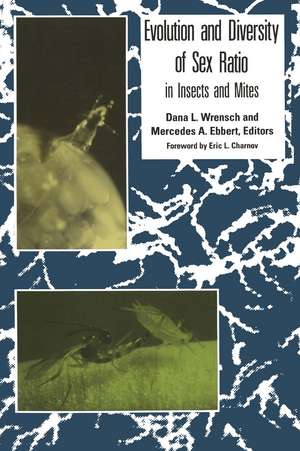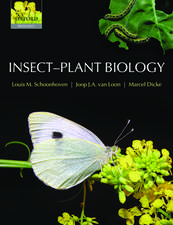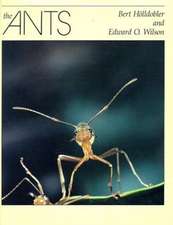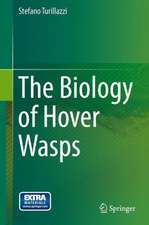Evolution and Diversity of Sex Ratio: in Insects and Mites
Editat de Dana Wrensch, Mercedes A. Ebberten Limba Engleză Paperback – 29 iun 1993
Preț: 656.25 lei
Preț vechi: 772.05 lei
-15% Nou
Puncte Express: 984
Preț estimativ în valută:
125.58€ • 134.28$ • 104.70£
125.58€ • 134.28$ • 104.70£
Carte tipărită la comandă
Livrare economică 17 aprilie-01 mai
Preluare comenzi: 021 569.72.76
Specificații
ISBN-13: 9780412022210
ISBN-10: 0412022214
Pagini: 634
Ilustrații: XVIII, 634 p.
Dimensiuni: 152 x 229 x 33 mm
Greutate: 0.86 kg
Ediția:New.
Editura: Springer Us
Colecția Springer
Locul publicării:New York, NY, United States
ISBN-10: 0412022214
Pagini: 634
Ilustrații: XVIII, 634 p.
Dimensiuni: 152 x 229 x 33 mm
Greutate: 0.86 kg
Ediția:New.
Editura: Springer Us
Colecția Springer
Locul publicării:New York, NY, United States
Public țintă
ResearchDescriere
Darwin first raised the question of sex ratio evolution, and saw it as both important and enigmatic. He was, however, unable to make much headway with the problem and declared it a puzzle for the future. This particular future arrived about 60 years later, when R. A. Fisher (1930) pointed out that under autosomal inheritance half of the genes passed to zygotes in any generation come from males and half come from females. Fisher noted that this one-mother/one-father symmetry generates frequency dependent natural selection on sex ratio, resulting in an evolutionary equi librium in which half of the reproductive resources are devoted to daughters and half to sons. Although widespread interest in sex ratio as a phenotypic trait did not occur for another 30 years, it is difficult for us to overestimate the impor tance of Fisher's brief and characteristically cryptic remarks. Almost all of the innovations in thinking about sex ratio can be viewed as alterations of one or more implicit assumptions in Fisher's scheme. The present book on insect sex ratios is testimony to the fruitfulness of his original ideas and of their descendants.
Cuprins
1. Phylogenetic Perspectives on Genetic Systems and Reproductive Modes of Mites.- Phylogeny and genetic systems of Parasitiformes.- Phylogeny and genetic systems of Acariformes.- Phylogenetic patterns in the distribution of thelytoky.- Patterns and ecological correlates of genetic systems in mites.- Patterns and ecological correlates of thelytoky in mites.- Summary and conclusions.- 2. Patterns of Reproduction in Insects.- The normal reproduction of insects.- Patterns of reproduction out of the ordinary.- 3. Evolutionary Flexibility Through Haploid Males or How Chance Favors the Prepared Genome.- A restrictive elaboration of Hamilton’s extreme biofacies.- “Restricted biofacies” of adaptive sex ratio regulation by haploid males.- Sex ratio control: the fertilization strategy that maximizes daughters.- An alternative model for the evolution of sex ratio regulation.- Haven’t we underrated the haploid male?.- Summary of the New ESSNET hypotheses: The rm*Smmodel.- 4. Endosymbiotic Sex Ratio Distorters in Insects and Mites.- Definition and documentation of endosymbiotic sex ratio distorters.- Male-lethal infections.- Incompatibility infections.- Conversion infections.- Bimodal transmission of distorter infections.- Coevolutionary selection on endosymbiont-driven sex ratio.- Conclusion.- 5. Evolution of Sex Determination and Sex Ratio within the Mite Cohort Tarsonemina (Acari: Heterostigmata).- Evolution of mode of reproduction.- Evolution of sex ratio.- 6. Sex Allocation Ratio Selection in Thysanoptera.- Measuring sex ratio and sex allocation in Thysanoptera.- Four biofacies of thrips sex allocation.- Ecology, social behavior, and sex allocation in thrips.- 7. Ecology and Evolution of Biased Sex Ratios in Bark and Ambrosia Beetles.- The natural history of inbreeding in Scolytidae.- Biogeographic patterns of inbreeding Scolytidae.- The evolution of close inbreeding in Scolytidae.- Sex ratios of inbreeding Scolytidae.- Other biased sex ratios.- Summary.- 8. Evolution of Sex Ratio Variation in Aphids.- Sex, non sex, and sex allocation in aphid life cycles.- Sex determination and the development of the sex ratio phenotype.- Selection on the sex ratio in aphids.- Fisherian Systems.- Systems with variation in local conditions.- Systems with population subdivision.- Potential for sex allocation investigations in aphids.- 9. Sex Allocation in Social Insects: Problems in Prediction and Estimation.- The central place of social insects in sex allocation studies.- Estimation.- Inclusive fitness.- Population interactions.- Intercolony variation.- Where to from here? How to evaluate the relative importance of the various factors affecting sex allocation?.- 10. Male Parentage and Sexual Deception in the Social Hymenoptera.- Inclusive fitness and colony social systems.- Sexual deception with monogyny and monandry.- Evidence and conclusions.- Summary.- 11. Sex Ratio and Virginity in Haplodiploid Insects.- Will virgin females reproduce?.- Evidence for unmated oviposition.- Some ramifications.- 12. Sex Ratio Manipulation by Parasitoid Wasps.- Sex ratio manipulation models.- Empirical support.- Limitations on sex ratio manipulation.- Summary.- 13. Sex Determination and Sex Ratio Patterns in Parasitic Hymenoptera.- Modes of reproduction.- Sex determination.- Causes and consequences of thelytoky.- Sex-ratio-distorting factors.- Sex allocation.- Sex allocation in structured mating systems.- Genetic variation for sex ratio.- Sex allocation and variation in fitness.- Conclusion.- 14. Sex Ratio Evolution in Parasitic Wasps.- Conclusions.- 15. Sex Allocation and Pseudoarrhenotoky in Phytoseiid Mites.- Paternal genome loss in males: evidence and phylogenetic distribution systems.- Selective advantages of uniparental male.- Sex allocation in phytoseiid mites.- Discussion 53116. Alteration of Sex Ratios of Parasitoids for Use in Biological Control.- Classical biological control.- Augmentative biological control.- Applications.- 17. Quantitative Genetics Applied to Haplodiploid Insects and Mites.- Basic concepts.- Genetic similarity between relatives.- Estimating heritability.- Response to selection.- Conclusion.- Author Index.- Taxonomic Index.













